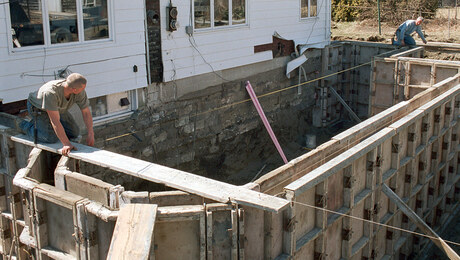Discussion Forum
I wonder what the veteran builders do when they run into a situation where attaching a rafter hanger to a truss does not allow all the nail holes to be filled for lack of lumber behind. I was going to attach a valley rafter to a raised heel girder truss with a Simpson LSSUI25, also tried a SUL1.81/11. Both would have unfilled holes. Now thinking of just using a bevel and seat cut on rafter then raising wall seven inches up to the seat. I would have to drill though the plates on the truss to nail the bevel of the rafter to it. Do you think this would pass inspection? Also I have a new found respect for people who remodel! Thanks for any help Dan
Discussion Forum
Up Next
Video Shorts
Featured Story

There are a number of ways to achieve a level foundation and mudsill.
Featured Video
How to Install Cable Rail Around Wood-Post CornersHighlights
"I have learned so much thanks to the searchable articles on the FHB website. I can confidently say that I expect to be a life-long subscriber." - M.K.

















Replies
I don't have all the info on your project, but it sounds like you should just nail the valley to the truss with 4 or 5 16d nails and keep going. The nails will find their own way through the gang nails. You don't always have to put hardware on every connection.
Have fun!
Rob Z, D&R Builders Inc.
You know I was thinking to myself you are making this way to complicated. When not sure I always over engineer, even called Simpson, that really complicated things. I think this web site is Great, expect more from the Doorman as this remodel continues. Thanks for the help Dan
I don't do remodeling - just new construction, but feel certain that any inspector around here would require a engineers letter to allow a valley rafter plumb cut to be attached to the side of a truss. OK - maybe not if it was a tiny valley.
You know the problem is the raised heel on the truss. With the wall top plate raised up to the seat cut, all the force would be down on the seat as in nore normal new construction. I plan on also adding studs to the wall under the seat cut to transfer load to the basement wall. Thanks Dan
I'm assuming the trusses are existing and you're adding to them? Depending on how critical the joint is there are four options I'd think of:
Get the best choice hanger and call for a consult with the inspector to ask him in person if it will fly. This way you know it will pass the framing inspection.
2nd, call a truss plant and have them send someone out to specify the correct connection and verify the truss is designed right for what you're doing. The inspector will go along with an engineered solution so this option has essentially zero risk of not passing, although they will charge you for the visit and a paper with the magic stamp unless the trusses are part of the new construction and the connection should have been specified in the first place.
3rd, add two layers of 3/4" cdx over a large enough area so it's obvious that you're overbuilding the reinforcement where the hanger is to go, roughly 3' x 4' on a past job. This provides a solid home for all the hanger nails. It seems like two 12d gun nails cinched every 4" along any contact with the truss for the first layer of cdx was an engineered fix we used on a remodel. The second layer is simply nailed over the first. It will take the most time and there's still no guarantee that the inspector won't say you need a truss company to make a decision on what you've done, but it results in a very solid connection that's easily attached.
4th, simply cut, nail without a hanger and keep fingers crossed that it passes and that if it doesn't, the fix won't take 3 days. You're probably adding a valley rafter that deeper than the truss so this probably isn't the best idea. It's amazing, but nails actually can attach two pieces of wood, and this may or may not be the best place to try it. Make a nice cut, plan out the ideal nail pattern and nail size. Predrill if you're going to split anything. The inspector is less likely to question the connection if it looks correct and has something other than 12d gun nails.
Good luck
Beer was created so carpenters wouldn't rule the world.
I have thought about seeing the truss manufacture which has helped in the past but just thinking I am bring this to far. The valley rafter intersects a girder truss above the top plate of the wall because of the raised heel on the truss. The truss also goes past where the corner of the building actually is thus the valley rafter needing a bevel cut. The seat cut is still mostly over the top plate of the wall. Thanks Dan
Not all hangers have to have full nailing in every situation. If you call Simpson's tool free number they have an engineering department for special situations. They will review the situation and make a recommendation.They'll want a heck of a lot of info from ya - Lumber species and grade, the amount of load you're trying to carry, etc. But they'll give you a drawing that you can take to the building department.
T-shirt: A Team Effort Is A Lot Of People Doing What I Say
Doorman,
I am assuming that this is the intersection at the outside wall you are discussing here.
I would block between trusses with a blocks ripped to the height and width (flat of the seat) of the bottom of the seat cut on the valley rafter. Sheathing should carry up that high anyway so that will anchor the block against uplift.
Then just nail the valley rafter to the girder truss and the blocking.
Hurrican ties if needed.
Unless someone comes up with a real good reason not to I have pretty much decided on doing just that. It seems the simplest and best, most times that the way to do it. As a added plus I have caught up on some desk stuff waiting for replies. Thanks Dan